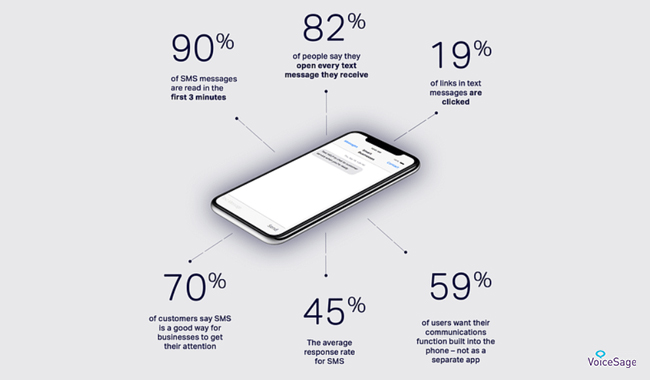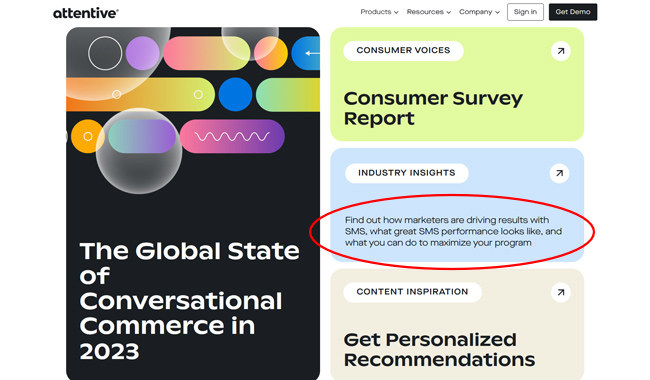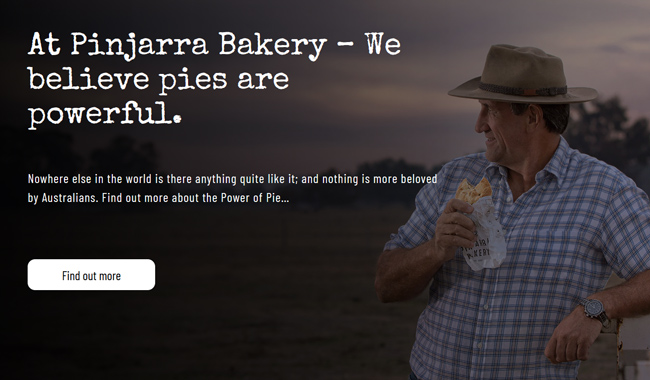As a business owner, there are probably many instances where you’ve wondered how to engage your customers to promote and grow your business.
In today’s world, numerous brands compete for the attention of consumers, making it necessary for you to develop creative marketing strategies to stand out.
And with how social media algorithms work, gaining traction through your marketing efforts can be a challenge.
That’s where SMS campaigns come in. When executed correctly, text message marketing is an incredibly effective way to reach your customers quickly and with positive results.
With a partner like OnDigitalMarketing, you’ll understand how to create customized SMS campaigns tailored to specific consumer behavior to promote customer satisfaction and loyalty.
As we explore the depths of SMS marketing, you’ll learn how to:
- Create engaging content for your SMS campaign
- Craft effective calls to action
- Understand and target the right audience
- Analyze the results of your campaign
- Upgrade your digital marketing skills by taking an in-depth course
SMS campaigns are a powerful tool for connecting with your customers. Let’s look at how you can effectively use it to grow your brand.
What Is an SMS Campaign?
An SMS campaign is an easy yet effective way to quickly reach a large audience and keep them connected.
According to a recent survey, 70% of customers agree that they prefer businesses to reach out to them through SMS. 82% of the people interviewed noted that they opened every text message they received.

Source: voicesage.com
This makes SMS marketing an indispensable tool for keeping in touch with and retaining your customers.
SMS makes it simple for businesses to create customized, automated sequences tailored to specific consumer behavior, send brief surveys, and provide customers with personal URLs and discount codes for data tracking.
When developing an SMS campaign, it’s important to remember to include opt-out options, as this is a legal requirement and helps maintain a subscriber list of people who want to be there.
In addition, you must ensure that you’re only sending messages to customers who have opted-in, as sending messages to non-opted-in users is not only illegal but also unlikely to lead to conversion.
Well-thought-out SMS campaigns return excellent positive results when engaging customers, boosting customer satisfaction and loyalty, and increasing the ROI of a business.
Did You Know? The world’s first SMS text message was sent in 1992 by Engineer Neil Papworth. It read “Merry Christmas.”
Benefits of SMS Campaigns
Supercharging your customer engagement has never been easier thanks to SMS campaigns. With well-timed, personalized, and relevant texts, you’re sure to get positive results.
These campaigns leverage automation and personalization for successful customer engagement. Message personalization helps you make your texts stand out, while automation strategies save you time and energy.
SMS campaigns help you stay in contact with customers and keep them engaged. Such campaigns allow you to send personalized messages with special offers, coupons, discounts, new product updates, and more.
A report by Attentive revealed that 81% of consumers subscribe to at least one brand via SMS.

Source: attentive.com
This strategy is also effective for conducting brief surveys, tracking data with personal URLs and discount codes, and boosting customer satisfaction and loyalty.
What’s more, SMS campaigns allow you to create customized, automatic sequences tailored to consumer behavior, and send drip messages or autoresponders for an immediate response, no matter the time of day.
If you’ve been looking for a hassle-free way to motivate customers to act on offers, text campaigns are the solution.
Urgency tactics with these campaigns help to increase response rates. For instance, stating that an offer is only valid until a particular date incentivizes the customer to purchase the product or service.
The table below compares SMS marketing to email marketing:
| Digital Marketing Strategy | Effectiveness | Benefits | Limitations |
|
SMS |
Direct and immediate communication Higher open rates |
Useful for personalized promotions, time-sensitive offers, appointment reminders |
Requires explicit consent from recipients and ensuring compliance with relevant regulations Limited content length |
|
|
Wide reach and personalized content |
Can be tailored to specific customer segments to provide relevant and targeted content |
Lower open rates Messages can be marked as spam |
Creating Engaging Content
Not all SMS campaigns are created equal. While some keep customers informed and interested in a brand, others end up as more of an annoyance with a barrage of valueless texts.
So, what separates the wheat from the chaff? How captivating the content of the campaign is.
Creating thoughtful content ensures you’ll forge meaningful connections and create an impactful dialog with your audience.
The process begins by targeting the right audience with the right message, which requires understanding the needs, interests, and behavior of your target audience and segmenting them into different categories.
For instance, clients in their teens through early twenties have different needs from those aged 50 and above. Creating separate campaigns for these groups is a fantastic strategy for keeping various types of customers hooked.
After understanding what your customers want, employ SMS automation to schedule messages to customers at specific times. One excellent strategy is offering discounts on their birthday or during special occasions such as Mother’s Day.
If you’re providing a food and beverage service, schedule the texts for around meal times.
This is what Pinjarra Bakery did to increase their success rate, by letting their most loyal customers know about the release of exclusive pies as soon as they came out.

Source: pinjarrabakery.com
At lunchtime, the bakery would send a marketing text about new one-off pies to their most devoted customers.
When these customers were happy with the pies, they spread the word to their friends and family, bringing more customers to the business.
From just two of such SMS campaigns, Pinjarra gained 15% more revenue in just over three months.
Adding an element of personalization is also important. For example, you can track customer data to determine their buying habits and offer them tailored rewards and promotions based on their preferences.
The report by Attentive highlights that over 74% of respondents expect a direct response from a real person instead of stiff responses from bots.
This rise in preference for conversational marketing means that businesses need to maintain the human touch while engaging with their customers through text.
Keep in mind that in this day and age, customers are constantly bombarded with information. It’s therefore important to keep your message short and to the point. Long messages are easily ignored, so be sure to include only essential information.
By taking the time to craft engaging content, your messages will stand out from the rest and your customers will appreciate the effort.
As long as you’re thoughtful and consistent with your messages, you’ll foster strong, lasting relationships with your customers.
“Either write something worth reading or do something worth writing about.“
— Benjamin Franklin
Crafting an Effective Call-To-Action
When creating an automated sequence, keep in mind that the messages should be clear and concise, with a practicable call-to-action (CTA). You want to encourage customers to take action, so make sure that the call-to-action is specific and easy to understand.
For instance, do you want your customers to follow you on social media, give a review of a certain product, or buy a product that’s currently discounted? This message should come out clearly in the campaign.
In addition, ensure that your call-to-action is relevant to the message.
If you’re sending out a promotional message, make sure that your call-to-action directs customers to that promotion. For a customer satisfaction survey, your call-to-action should direct them to that survey. Customers shouldn’t be confused about what you want them to do.
Apart from the clear CTA, also provide your customers with an easy way to take action. The easiest way to do this is by including a link for customers to click on to take action.
If your customers have to search through the message for the call-to-action, this might frustrate them and make them unlikely to follow through to the end.
A well-worded call-to-action falls short of its purpose if it isn’t timely. For example, a promotional message needs to have a deadline for when the promotion will end. If you’re sending out a customer satisfaction survey, include a deadline for when the survey ends.
This will ensure your customers don’t miss out on the opportunity to take the required action.
Warning: Avoid using generic phrases like “click here” as your CTA. Your customers need to know what they’re clicking on and why they should do it.
Timing Your Messages
“We must use time as a tool, not as a cradle.“
— John F. Kennedy
Automated sequences are great for delivering messages at the right frequency and timing, allowing you to plan and schedule messages in advance.
When timing your messages, be mindful of your customers’ preferences. This means understanding when they’re most likely to be active and open messages.
It’s also key to consider the time of day and time zone differences. It’s easy to forget that customers may be in different parts of the world, so it’s essential to take this into account when sending messages.
Remember that the frequency of your messages matters. Too many messages may cause customers to become overwhelmed and unsubscribe, while too few messages can lead to customers forgetting about your brand.
To avoid this, make sure you’re sending the right number of messages at the right time. A good way to do this is to track your customers’ behavior and use that data to send messages at the appropriate time and frequency.
Targeting the Right Audience
Understanding your target demographics and their needs is key to creating effective SMS campaigns.
Start by gathering audience insights and segmenting your customers into smaller groups based on their interests and preferences.
The women’s clothing store TC Elli’s uses customer segmentation to create spot-on marketing campaigns, catering to a variety of desires and behaviors. Using data from their POS, they categorized their customers into:
- At-risk customers
- Lost customers
- Best customers
- Promising customers
- New customers
- Loyalty program customers
When TC Elli’s launches a buy-2-get-1-free offer, they send marketing texts to their best loyalty program and promising customers. These clients are likely already deeply engaged with the brand, thus giving the SMS campaigns the highest chance of success.
Data tracking is also fantastic for seeing which types of messages customers are responding to, and helps you adjust your strategy accordingly.
Another avenue for collecting valuable customer data is to incentivize customer participation with text-in competitions and giveaways. You can also offer exclusive deals and discounts to your most loyal customers, as well as promote your latest products and services.
Above all else, the tried and tested route of customer feedback rarely fails. Ask customers for their opinion and use their responses to tailor your messages and create a more personalized experience.
For example, for a beauty products store, do customers prefer one type of oil over another? Would they rather order online or pick up in store? Answers to such questions are helpful in developing meaningful text-based campaigns.
Asking for feedback makes your customers feel valued and appreciated, and encourages them to keep interacting with your brand.
Expert Tip: Incentivizing your customers to offer their feedback with rewards for reviews, testimonials, or text-in competitions helps to build relationships and increases engagement.
Analyzing Your Results
Once you’ve sent out your SMS campaigns, it’s time to analyze your results and see where the opportunities lie for further optimization of your strategy.
Start by tracking the following metrics to gain valuable insights into your campaigns:
- Analyzing data: Track opens, clicks, and conversions to help you identify how effective your texts are.
- Tracking metrics: Monitor performance metrics such as response rate, delivery rate, and bounce rate to track the success of your campaigns.
- Monitoring trends: Look for trends in customer behavior to inform your future campaigns.
Analyzing your results is important for growing engagement, tracking ROI, and enhancing your SMS campaigns. Use the data you collect to create more effective messages that will resonate with your customers.
By understanding the impact of your campaigns, you’re able to make informed decisions to better engage your audience and achieve your business goals.
With the right data and insights, you’ll drive higher sales and build stronger relationships with your customers.
Here’s a table outlining common challenges in SMS campaigns, their impacts on your key metrics, and some mitigation strategies.
| Challenge | Impact On Metrics | Mitigation Strategy |
| Ineffective Call-to-Action (CTA) | Low Conversion Rate | Craft clear, compelling CTAs Test different versions to find the most effective ones |
| Spammy Content | High Opt-Out Rate | Keep your messages valuable and relevant Avoid “spammy” language Respect your customers’ communication preferences |
| Poor Timing | Low Open Rate | Analyze customer behavior to identify the best times to send messages |
| Over-Saturation (Too Many Messages) | High Opt-Out Rate | Balance the frequency of your messages to avoid overwhelming your customers |
| Incomplete or Misleading Message Content | Low Conversion Rate | Ensure all necessary details are included in the message and set the right expectations |
Develop Effective SMS Campaigns by Taking a Digital Marketing Course

You now have all the tools you need to create powerful SMS campaigns that engage customers and promote your business.
With the right content, calls-to-action, timing, and audience, you’ll be able to quickly and efficiently reach your customers with customized offers and information.
Ready to upgrade your digital marketing knowledge and tactics? Consider signing up for our email newsletter for exclusive tips and workshop courses to help you stay up to speed with the best practices and trends in the industry.